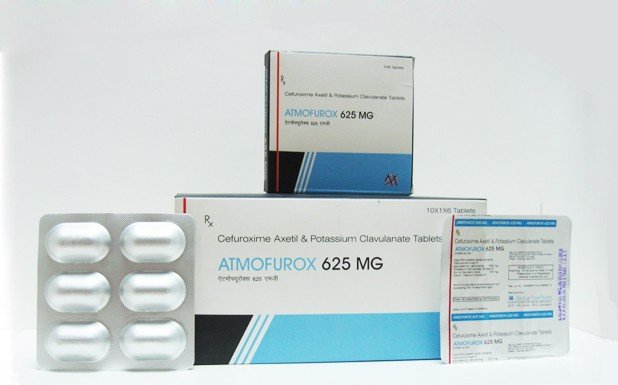
Composition
- Each Uncoated Tablet Contains:
- Cefuroxime Axetil
500 mg
- Clavulanic Acid
125 mg
Packing
- 10x1x6
(Alu-Alu)
MRP
- 248
Overview
Atmofurox-CL 625MG comprises of Cefuroxime Axetil & Clavulanic Acid which is used to prevent or treat infections that are proven or strongly suspected to be caused by bacteria. Cefuroxime is an antibiotic. It works by preventing the formation of the bacterial protective covering which is essential for the survival of bacteria in the human body. Clavulanic Acid is a beta-lactamase inhibitor which blocks the action of enzymes produced by bacteria to inactivate Cefuroxime. Addition of Clavulanic Acid reduces resistance and enhances the activity of Cefuroxime against bacteria.
Indications
- Pharyngitis/tonsillitis
- Acute bacterial otitis media
- Acute bacterial maxillary sinusitis
- Acute bacterial exacerbations of chronic bronchitis and secondary bacterial infections of acute bronchitis
- Uncomplicated skin and skin-structure infections
- Uncomplicated urinary tract infections
- Uncomplicated gonorrhea (urethral and endocervical)
- Early lyme disease (erythema migrans)
Warnings
Cephalosporins, including cefuroxime, should be given with caution to patients receiving concurrent treatment with potent diuretics because these diuretics are suspected of adversely affecting renal function.
Clavulanate potassium has been used to treat infections caused by Eikenella corrodens or Pasteurella multocida and infections caused by anaerobic and mixed aerobic-anaerobic bacterial infections.
Contraindications
Hypersensitivity to the cefuroxime, to any of its components, or to any of the cephalosporin group of antibiotics.
Dosage
Dosage based on the condition as directed by the physician.
Pharmacology
Pharmacodynamics properties of cefuroxime axetil
Cefuroxime axetil is a bactericidal agent that acts by inhibition of bacterial cell wall synthesis.β -lactamases,
both penicillinases and Cefuroxime axetil has activity in the presence of some cephalosporinases, of gram-negative
and gram-positive bacteria. Resistance to cefuroxime axetil is primarily through hydrolysis by β-lactamase,
alteration of penicillin-binding proteins (PBPs), decreased permeability, and the presence of bacterial
efflux pumps.
Clavulanic acid
Clavulanic acid is a beta-lactam Inhibitor structurally related to the penicillins.It competitively and irreversibly inhibits a wide variety of beta-lactamases, commonly found in microorganisms resistant to penicillins and cephalosporins. Binding and irreversibly inhibiting the beta-lactamase results in a restauration of the antimicrobial activity of beta-lactam antibiotics against lactamase-secreting- resistant bacteria. By inactivating beta-lactamase (the bacterial resistance protein), the accompanying penicillin/cephalosporin drugs may be made more potent as well.
Pharmacokinetic properties of cefuroxime axetil
Absorption:
It is absorbed from the gastrointestinal tract and rapidly hydrolyzed by nonspecific esterases in the
intestinal mucosa.
Distribution:
It is distributed throughout the extracellular fluids. Approximately 50% of serum cefuroxime is bound to protein.
Metabolism:
The axetil moiety is metabolized to acetaldehyde and acetic acid.
Elimination:
Excretion occurs mainly through the kidney both by glomerular filtration and tubular secretion.
Clavulanic acid
Absorption:
Well absorbed aprx. 75%.
Distribution:
Clavulanate cross the placental barrier, and low concentrations appear in breast milk. clavulanate
potassium have minimal protein-binding of 22% to 30% to human serum.
Metabolism:
It is metabolized in the Hepatic.The metabolic fate of clavulanate potassium is not completely
identified, but it appears to undergo extensive metabolism.
Elimination:
It is excreted by glomerular filtration.
Microbiology properties of cefuroxime axetil:
Cefuroxime has bactericidal activity against a wide range of common pathogens, including many beta-lactamase producing
strains. Cefuroxime is stable to many bacterial beta-lactamases, especially plasmid-mediated enzymes that are commonly
found in enterobacteriaceae.
Cefuroxime has been demonstrated to be active against most strains of the following microorganisms:
Aerobic Gram-Positive Microorganisms:
Staphylococcus aureus (including beta-lactamase producing strains)
Streptococcus pneumoniae
Streptococcus pyogenes
Aerobic Gram-negative Microorganisms:
Escherichia coli
Haemophilus influenzae (including beta-lactamase producing strains
Haemophilus parainfluenzae
Klebsiella pneumoniae
Moraxella catarrhalis (including beta-lactamase producing strains)
Neisseria gonorrhoeae (including beta-lactamase producing strains)
Spirochetes:
Borrelia burgdorferi
Cefuroxime has been shown to be active in vitro against most strains of the following microorganisms;
however, the clinical significance of these findings is unknown.
Aerobic Gram-negative Microorganisms:
Aerobic Gram-Positive Microorganisms:
Staphylococcus epidermidis
Staphylococcus saprophyticus
Streptococcus agalactiae
Anaerobic Gram-positive Microorganisms:
Morganella morganii
Proteus inconstans
Proteus mirabilis
Providencia rettgeri
Anaerobic Microorganisms:
Peptococcus niger
Side Effects
Nausea
Headache
Indigestion
Diarrhoea
Abdominal pain
Heartburn
Pregnant and Lactating Women:
Pregnant and lactating women should take this medication only under the prescription of the physician